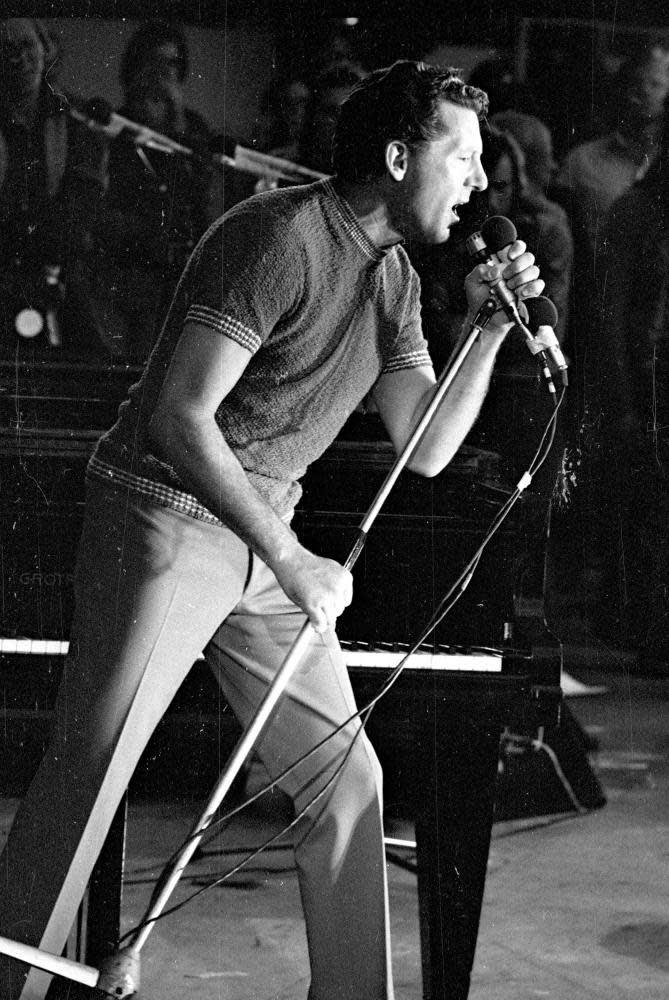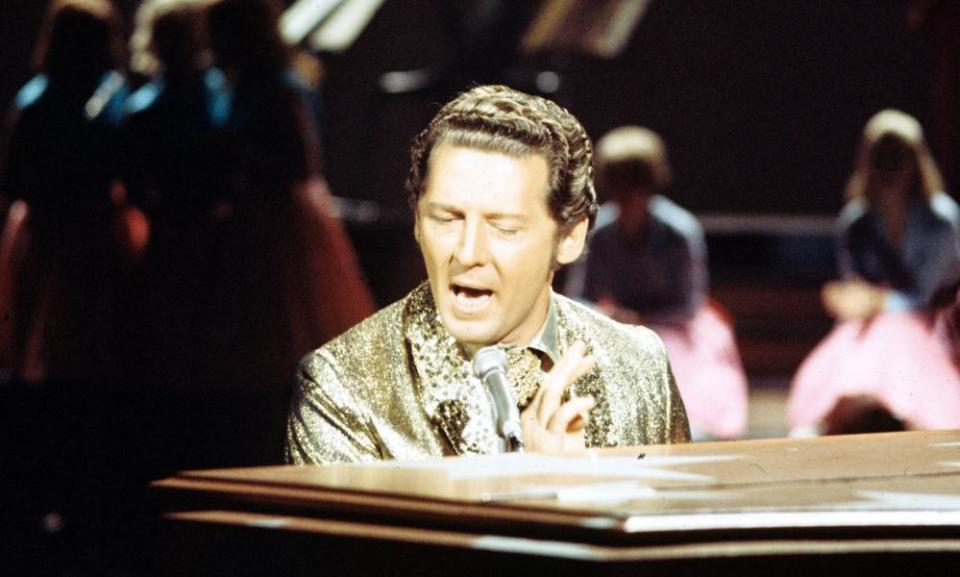Jerry Lee Lewis: a thrilling one-of-a-kind showman who was mired in scandal
In October 1973, Jerry Lee Lewis was booked to play a showcase gig at the Roxy, a newly opened LA club that immediately attracted a clientele heavy on rock stars: among its co-owners were David Geffen, Neil Young’s manager, Elliot Roberts, and the famed producer Lou Adler. Lewis was, in theory at least, in the throes of another comeback. He had just completed work on an album called The Session, recorded in London with an all-star backing band: Kenney Jones of the Faces, Rory Gallagher and Peter Frampton among them. By all accounts the sessions hadn’t gone terribly well. Propped up by booze and amphetamines, Lewis’s behavior was volatile: Rory Gallagher recalled that whenever something displeased him, Lewis would reach for his sock, where, it was believed, he concealed a gun. Still, the combined contemporary star power of his guests helped the album to Lewis’s highest US chart placing in a decade.
Related: Jerry Lee Lewis, notorious US rock’n’roll star, dies aged 87
But if Lewis was pleased about the attention paid to him by a younger generation of musicians, he had a funny way of showing it: when John Lennon walked into the Roxy that night, Lewis stopped playing and began berating him from the stage: “[he] started on about how the Beatles were shit and the Stones were shit and there ain’t nobody could play real rock’n’roll the way Jerry Lee could,” recalled Gallagher. For his part, Lennon seemed entirely unbothered. After the show, he walked into Lewis’s dressing room, dropped to his knees and kissed his feet, before asking for an autograph from the man he called “the real king of rock’n’roll”.
It’s an incident that tells you something about Jerry Lee Lewis himself, but a lot more about the kind of reverence in which he was held by people who could remember the impact of his early singles. Sixty years on, it’s hard to imagine what music as feral and raw as Whole Lotta Shakin’ Goin’ On or Great Balls Of Fire must have sounded like to a kid in late-50s Britain, not that long after rationing had. Just a year before, pop music had meant Doris Day and Ronnie Hilton and Winifred Atwell: it was cosy light entertainment, aimed at adults, who’d lived through the second world war and wanted a quiet life. But now it meant this: a man who appeared to be genuinely unhinged – who had apparently earned the nickname “The Killer” after he attempted to strangle one of his high school teachers with his own tie – kicking his stool away, pounding the keyboard with his heel and leaping on top of the piano, playing music that was intense, visceral, sexual and completely incomprehensible to anyone over the age of 20, the sound of a generation gap being torn open. But you can get an idea from the way musicians who were kids then behaved around Jerry Lee Lewis decades later. John Lennon kissed his feet; when Elton John – who happily admitted his debt to Lewis’s playing and his brand of showmanship – was finally ushered into Lewis’s presence backstage at a US festival in 2015, he was, it was reported, visibly shaking with nerves.

It’s tempting to say that the music he recorded at Sun Studios between 1956 and 57 was so potent and impactful that it rendered Lewis weirdly bulletproof. That’s certainly one explanation of how he survived enough personal scandal to destroy anyone else’s career several times over. As the journalist Nick Kent noted, Nick Tosches’ masterly Lewis biography Hellfire was a book in which “havoc inevitably reigns: in-laws go mad or become accident statistics, offspring die horrible, mangled deaths, wives drown or suffer inexplicable fatal overdoses … record people are terrorized, audiences verbally and physically attacked, promoters bankrupted, journalists threatened with broken bottles … while The Killer just keeps on rocking”.
He liked to tell people he had served his musical apprenticeship in a juke joint in his home town of Ferriday, Louisiana, called Haney’s Big House: “the evilest, baddest, lowest fighting– and –killingest place on Earth”. What he learned there is a moot point. The sound of raw black rhythm and blues ran through his playing, but Lewis was never big on naming his influences, although he would occasionally confess a fondness for Moon Mullican, the self-styled “King Of The Hillbilly Piano Players” who claimed his music could “make them goddam beer bottles bounce on the table”. If he thought he was going to follow Mullican’s career path, however, he was mistaken: before he fetched up at Sam Phillips’s Sun Studios, Lewis moved to Nashville, but was rejected by every bastion of country music, including the Grand Ole Opry and the Louisiana Hayride.
But he fitted perfectly into the febrile, risk-taking atmosphere of Sun’s golden age. A blues fan, Sam Phillips had started out largely recording black performers, but having discovered Elvis Presley, increasingly concentrated on artists who muddied the boundaries between R&B, country and hillbilly music. It was at Sun that Lewis’s mercurial unpredictability was noticed by Phillips, who responded by simply keeping the tapes running until something happened – these were the circumstances in which Whole Lotta Shakin’ Going On was captured – and it was at Sun that the stage-shy Lewis was encouraged to put on more of a show by his label mates Johnny Cash and Carl Perkins, advice he ran with in no uncertain terms. It took one frenzied appearance amid the comedians and variety acts on Steve Allen’s Sunday night TV show to turn Lewis into a national star, but he worked incessantly, taping a phenomenal quantity of music in a short space of time: in addition to his own recordings, he added piano to tracks by Perkins and Billy Lee Riley, changing the sound of rockabilly in the process. It was as if, for all his bluster – and Lewis was never reserved when it came to proclaiming his singular genius – Lewis thought his time in the spotlight might be short-lived. For one thing, rock’n’roll was still thought of as a passing fad. And then there was Johnny Cash’s theory: the God-fearing Lewis was tormented by the belief his music was sinful and leading both him and his audience to eternal damnation.
In the end, it was something more prosaic that did for him: the discovery by the British press in 1958 that he had married his 13-year-old cousin Myra Gale Brown. The reality was even more shocking. Lewis was also a bigamist: his divorce from his second wife, Jane Mitchum, had not been finalized when he married Brown, just as his divorce from his first wife, Dorothy Barton, had not been finalized when he married Mitchum. In the aftermath of the scandal, his career plummeted. Lewis scored a solitary hit single in 1961, a cover of Ray Charles’s What’d I Say, but his records were blacklisted, and the fees he could command for live performances slashed: “He went from making $100 a week to $100,000 a week and right back again,” noted Adam Fields, the producer of the 1989 Lewis biopic Great Balls of Fire, “and I don’t think he’s ever understood why.” He changed labels, and made records under pseudonyms to little effect, his woes compounded by changing tastes and the arrival of the British Invasion.

At his lowest point in 1964, a German producer taped his performance backed by the Nashville Teens at Hamburg’s Live at the Star Club, ironically one of the Beatles’ pre-fame haunts. Roughly recorded, it captured the astonishing sound of Lewis with his back against the wall. Audibly accelerated by something – whether rage, bitterness or chemicals – it’s a performance of scarcely believable ferocity: from the first note, the backing musicians struggle to keep up with him. The end result is undoubtedly the greatest album Lewis ever put his name to. It may well also be the greatest live album ever made or the greatest rock’n’roll album of all time: whichever you choose, it’s an implausibly thrilling listen.
But it did nothing to help his cause back home: Live at the Star Club wasn’t even released in the US. Instead, he resurrected his career by concentrating on the country music that had always formed part of his repertoire: even amid the madness of the Star Club performance, he found time to play Hank Williams’s Your Cheatin’ Heart. His country recordings were tough and sparse, at odds with the late-60s trend for slickness. They were also hugely successful: cannily repackaged, even country tracks he’d cut in the 50s at Sun became belated hits. He was invited to the Grand Ole Opry and, clearly still stung by the memory of his earlier rejection, gave a spectacularly disdainful performance, ignoring demands that he avoid his rock’n’roll songs, performing for 40 minutes instead of his allotted eight, and announcing to the audience that he was “a rock’n’rolling, country and western, rhythm and blues singing motherfucker”. He was not asked back.
Lewis spent the rest of his life alternating between country and rock’n’roll, the latter frequently at the behest of artists at least a generation younger than him: his hit 2006 album Last Man Standing saw him duetting with an all-star cast that included Mick Jagger, Bruce Springsteen, Jimmy Page and Rod Stewart, a formula its follow-up, Mean Old Man repeated. His personal life remained as terrifyingly chaotic as ever. At his 41st birthday party in 1976, he shot his bass player, Norman Owens, apparently by accident: later the same year, he was arrested outside Elvis Presley’s home Graceland after drunkenly crashing his car – which had a loaded gun on its dashboard – into the gates. He was plagued by health issues: in 1981, a ruptured stomach nearly killed him. A 1984 Rolling Stone investigation baldly accused him of abusing his fourth wife, Jaren Gunn, and of having some involvement in the death of his fifth, Shawn Stephens, although the allegations were unverified. Then there was the saga of his cousin Jimmy Swaggart, the televangelist who became embroiled in sex scandals involving prostitutes: “we all got our urges,” offered Lewis in his defence.
Somehow, Lewis’s career kept going: he even seemed to find some kind of stability towards the end of his life, with his seventh wife Judith Brown, although his ability to terrify interviewers remained fully intact. He released records intermittently, but remained a huge draw live. By 2019, he was one of the last living links to the 50s rock’n’roll explosion still regularly performing, although he would doubtless have told you that he was without peer even when the rest of them were alive. “There ain’t never been anyone as good as me,” he said in the late 80s. “There ain’t never been anyone who could cut me, boy.” Certainly, there was never anyone like him, although plenty of artists followed in his wake, either energized by the astonishing music he made in the 1950s, or hypnotized by his stage presence, or seduced by the notion of the rock star as a terrifying, ungovernable force of nature, a notion he more or less invented. “I don’t have nothing to prove to nobody,” he once noted. “I just like to kick ass is all.”

 Yahoo News
Yahoo News 
